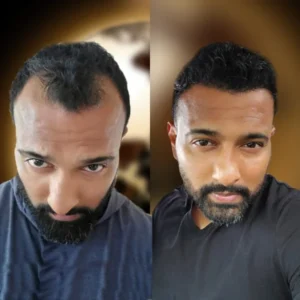One of the most common questions people ask regarding hair transplant surgery is what to expect right after, and when they can get back to their regular routine.
Well, during the first few days following the operation, you will notice that lots of tiny scabs have formed in the recipient area. The scalp will also be swollen and painful to the touch, with visible irritation, and may feel itchy.
While this is all a normal part of the post-op process and your body’s way of healing, there are a few things you need to know to ensure optimal results after a hair loss treatment.
We will go over some basic definitions and look at the post-op timeline and what you can do to speed things along and prevent any risks.
What Are Hair Transplant Scabs?
As a hair transplant procedure involves making tiny incisions in the scalp, it leaves the patient with thousands of microscopic wounds that will take some time to fully heal. This happens over a span of days and weeks, in several distinct stages.
First, as the skin has received some slight damage, your body’s priority is to address this as quickly as possible. Just like with any other type of cut, the natural healing process is for the blood to coagulate, leading to scab formation.
This helps quickly close up wounds in the skin, protecting them from infection, preventing excessive bleeding, and allowing the underlying tissue to heal properly over the course of a few days, at which point the scabs will start to fall off on their own. It also allows the grafts to begin securing themselves in the recipient area without any outside interference.
There are, however, a few important things to consider when dealing with transplant scabs, as you want to be careful not to damage the hair grafts.
How Long Do Scabs Last After Hair Transplant?
Scabs can form within a day after surgery or up to 3 days later in each of the follicles as a protective layer and will fall off naturally after 7 to 14 days. The specific amount of time varies from case to case, and depends on factors like skin type, the type of surgery, the total number of grafts, and how well the patient adheres to the prescribed aftercare procedures.
For most people, the scabs will form, crust over, and fall off two weeks after their procedure, and there are things you can do to promote faster healing and allow them to fall off sooner without irritating or dislodging the grafts.
How Do I Remove or Soften My Hair Transplant Crust?
As with all wounds that have formed a layer of crust, it’s common for the person to try to scratch them off at some point, as the area will feel itchy, and people also have a natural tendency to pick away at any rough spots on the skin.
However, you must not do this, as you can dislodge the implanted grafts, increasing the risk of infection and poor results. The key is to soften it up so that it can get loose quicker and make it easier to wash away with a gentle stream of water in the shower.
Instead of trying to brush or scratch at the crusty parts, focus on the following options:
Wash Your Hair Carefully
After the first 4 days, you can begin to use warm water (not too hot) and shampoo for sensitive skin to clean your scalp. Lather your hands up with the shampoo and lightly touch your head to apply a small amount, then just let the water run over it and wash everything away, and let the scalp dry off on its own. Don’t scrub your head or rub it with a towel.
These light showers will soften up the area and help the scabs fall out faster without disturbing the new hairs.
Use Natural Oils to Moisturize
As you get to day 10 post-operation, you can start applying any lotion or oil that the doctor at the hair clinic has prescribed to reduce the redness, irritation, and itchiness.
Of course, you should be careful and only dab the area lightly with your fingertips, applying a little bit of the oil at a time. You can repeat this procedure 2–3 times throughout the day, whenever you feel that your scalp is getting a bit too dry.
Is It Important to Remove Transplant Scabs?
In most cases, simply washing the hair and moisturizing will be enough, and everything should resolve itself within two weeks. However, if they don’t fall off on their own, you’ll need to have the scabs removed through different methods.
Removing these crusty spots from the scalp is essential, as they can get caught on clothes and torn off, damaging the grafts, and can impede proper hair growth.
Again, never try to scratch them with your nails – lightly dab them with a moist towel during the third week post-surgery, and you can start applying light pressure in circular motions with your fingertips beginning with week four.
How Important is Hair Transplant Aftercare?
Taking all the proper precautions and using all the aftercare methods we have mentioned is a crucial part of the hair transplant process.
While it all begins with the operation, where experienced surgeons will use the latest equipment to ensure maximal graft viability and natural-looking Hair transplant before and after results, the two-week period right after is when the follicles are most vulnerable.

During this time, they haven’t yet been fully secured in the implant site, so there is still swelling and irritation to deal with. You also have to be careful to avoid infection, and applying pressure to the area or tearing off scabs can damage the grafts.
That’s why you need to be careful with the scabs after a hair transplant and follow your doctor’s recommendations to the letter. However, the whole process isn’t too difficult to manage, and a vast majority of patients report a swift recovery and impressive results after their hair transplant in turkey.

